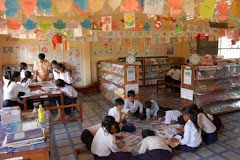In the Dominican Republic something wonderful is happening -- it's bringing the world of kids together with the world of art -- and it's something we can all be a part of!
Today we share this story in honor of all our artist/illustrator friends who make such beautiful art and art-covers for children's and YA books today. In particular we want to high-light an artist and art teacher from the Dominican Republic named Valentin Acosta.
This is one of Valentin's Great Paintings! Click the link to see more.
I met Valentin accidentally a few weeks ago when I stumbled across an art show that he and a group of young people were setting up in the yard and driveway of a building labelled "art school" in a little town called Jarabacoa way out in the countryside of the Dominican Republic.
Valentin is a member of a group of world-class visual artists who live, paint, and sell their works around the world, and also in a little Gallery in the tiny town of Jarabacoa. They have congregated there for red wine and coffee, and artistic camaraderie. And in that little town in the middle of no-where art that is catching attention of art collectors all over the world is being made.
But these artists, and Valentin in particular, are not simply thinking about themselves -- about how they can use their talents in art to make a living, or a statement, or even to make the Fine Art that they are making that is worthy of Galleries and Museums and Fine Art Magazines around the world. Of course they are doing all of those things, like all other great artists do.
But in addition to that they've started an art school for impoverished children in the Dominican Republic -- low-income Dominican kids who need mentors, who need opportunities, and who now because of being part of Valentin's school, after school, are finding safe outlets, self-respect, and a future
-- in life and in Art.
Like many Children's Book Illustrators who we personally know and love, these world-class painters are spending their own time, and their own money, to run this school, to raise up these young people with lessons in art and lessons of Life. One of their students has already grown up and gone on to art college in the big city. Others are still kids, learning about art, and self-esteem, and friendship, and enjoying having a place of learning, and color, and beauty and creativity to call their own.
But art supplies are expensive and the school is a non-profit.
VALENTIN and the other artists WOULD LOVE YOUR HELP to keep it going!


HOW CAN YOU HELP?
The school also is always willing to accept donations of general funds -- big or small donations -- to help cover the costs of paints, easels, and other art supplies to keep the school running as the artists donate their time.


So if you're interested in ways that art is making a difference in the lives of kids around the world today check out Valentin's work with the kids at The non-profit MWVA Art School (AKA MWVA Centro de Arte)
You can email Valentin Acosta and the leaders of MWVA in Spanish or English if you'd like to donate funds or supplies, to sponsor a student, or to help this effort in some other way. (Their website says Email: mwva.centrodearte@gmail.com)
Thanks Valentin and MWVA for letting us share your story, as well as the photos of your art, and the art and faces of your students today on Writermorphosis! (All photos on this post are the property of MWVA).































